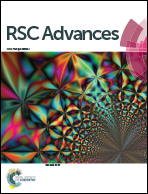Performance of an ionomer blend-nanocomposite as an effective gas barrier material for organic devices†
Abstract
A new, flexible, gas barrier material has been synthesized by exfoliating organically modified nano-clays (MMT) in the blends of Surlyn (PEMA) using a copolymer of vinyl alcohol (EVOH) and demonstrated as a gas barrier material. The materials were characterized by Fourier transform infra red (FTIR) and UV-visible spectroscopy, differential scanning calorimetry (DSC), thermo-gravimetric analysis (TGA) and tensile studies. The oxygen and water-vapor permeabilities of the fabricated films were determined by calcium degradation test and a novel permeability setup based on cavity ring down spectroscopy, respectively. Hierarchical simulations of these materials helped us to understand the effect of intermolecular interactions on diffusivities of oxygen and water molecules in these materials. Schottky structured poly(3-hexylthiophene) based organic devices were encapsulated with the fabricated films and aging studies were carried under accelerated conditions. Based on permeability test results and accelerated aging studies, the fabricated PEMA/EVOH/MMT composites were found to be effective in decreasing the permeabilities for gases by about two orders of magnitude and maintaining the lifetime of organic devices.


 Please wait while we load your content...
Please wait while we load your content...